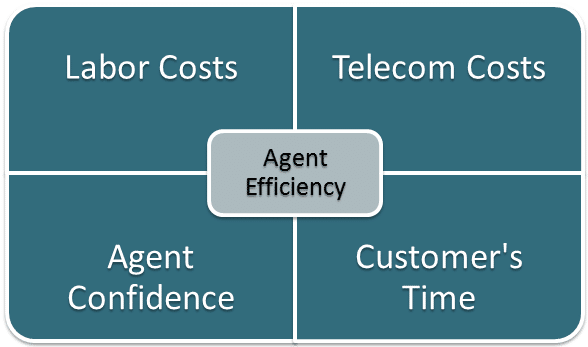Contact Center Agent Efficiency
It costs money to staff a contact center, that’s a given. The healthy contact center is tuned to get the most value from this investment. The efficiency of your contact center agents reflects how well agents are set up for success by your organization. This “cost-driver” analysis, a part of our VoiceVision 14 point Diagnostic Evaluation, is a fundamental measuring stick for a wide swath of the health of your Telephony Universe, and one where the costs and benefits are clear and measurable.

How long are your agents on the phones, or even doing after call work? One might define agent efficiency simply by measuring the number of transactions an agent can accomplish in a given day. But the optimal metric for agent efficiency must include a factor for maintaining the desired customer experience level while striving to process a maximal number of transactions. The customer experience qualifier is critical, and will vary wildly from business to business, industry to industry. The contact center needs to strike a balance where agents are trained and equipped such that they can provide solutions quickly, but the agent must also be authorized to give each customer the time they need. If you shortchange a customer on time simply to reduce call time, chances are you’ll be hearing from that customer again, and customer satisfaction will suffer.
So, while we can’t set a universal target efficiency level, we can look at the where the costs and customer experience impacts come from, and use that analysis to make the adjustments appropriate to your business.
Labor Costs
Bodies in seats, whether in a brick and mortar Contact Center, virtualized at home, or outsourced overseas, does provide a form of universal measure. We want to minimize the labor hours of our agents. So the question is what do they spend their time doing when on the clock?
To begin to understand the whole picture, break down the measurement of agent time to segregate between time processing contacts (phone, email, chat, etc,), after call work, training, and other corporate duties. Like most things in business, it’s a balancing act. There’s no magic formula.
Be careful, even, when setting targets within your own organization. Every agent has his or her own pace. Ask yourself questions like, “If I had Agent X spend 4 more hours a month in training, could I cut off 5 minutes per call?,” and analyze the return that way.
Telecom Costs
The other clock that’s almost always ticking is the toll charges from your telecom provider. Inbound toll free minutes carry a cost to you as the call center, and those pennies per minute add up in large contact centers.
Think about your handling process if your agents put callers on hold often and for extended periods of time. Why is the hold necessary? Is your customer talking to an agent who’s under qualified? If your agents frequently need to escalate calls to a supervisor, this might be the case.
What is preventing the agent from completing the request on his or her own? If you have to be stuck with a delay-filled process, start looking at other technologies and techniques that will allow you to spare the customer from time on the phone, racking up your phone bill.
Virtual Hold could be one example that can shave off valuable minutes of phone time, if not agent time. Cutting down on hold time could help free up phone lines too, allowing IT to operate with less capacity and reduce line charges.
Customers’ Time
We’ve seen that time is money for you as the contact center. Acknowledging the value of the customer’s time is a fundamental pillar of good customer experience. Your agents’ ability to process transactions the first time, (coupled with a streamlined IVR) is critical to a positive customer experience.
Most people who call your contact center will know what they want before they call. Assuming your auto-attendant routed them to the right agent, customers expect that agent knows the business process they are responsible for, has the authority to complete the transaction, and is competent to get the task done.
Anything less, and the customer will perceive disorganization, and lose confidence in your brand.
Agent Confidence
Lastly, agents will know whether they are set up for success. Attrition and turnover is costly, so give the agents the tools they need to do their job. The best contact centers have training that is thorough and relevant to the task assigned, systems that manage the business process so that the agents always know what their options are, and communications tools that ensure a quality conversation.
By providing the agents with an environment to breed success, they’ll feel empowered and confident. The customer will appreciate their ability to help with their need, and the agents should be less susceptible to burnout.
Find out more about the VoiceVision 14 Point Diagnostic Evaluation process by reading our white paper – Assessing your Telephony Universe.
